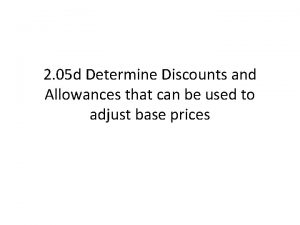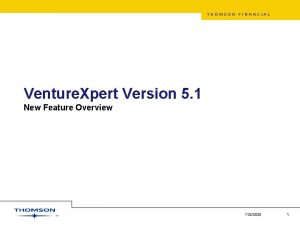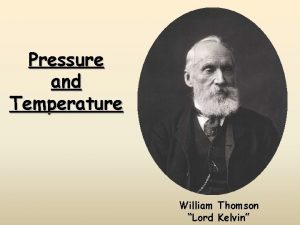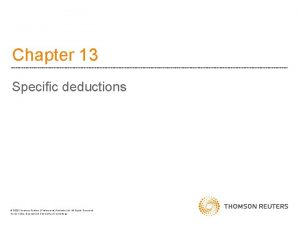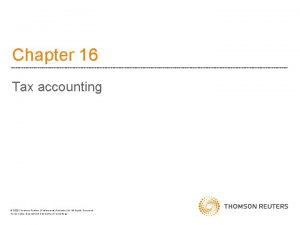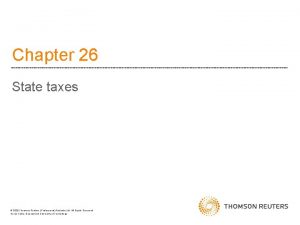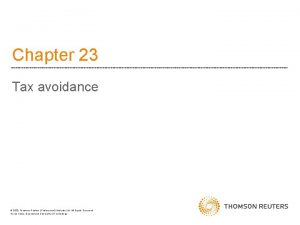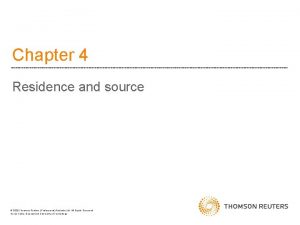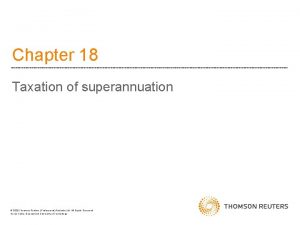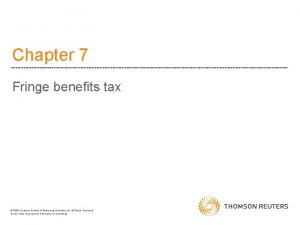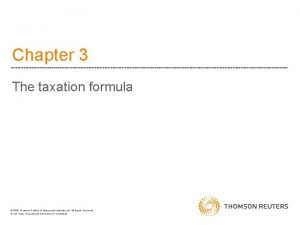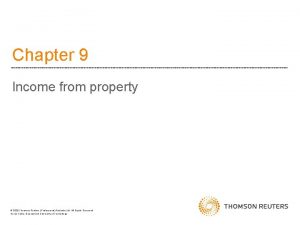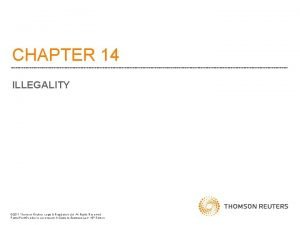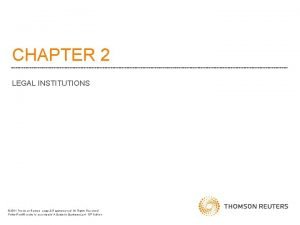Chapter 14 Capital allowances 2020 Thomson Reuters Professional






































- Slides: 38

Chapter 14 Capital allowances 2020 Thomson Reuters (Professional) Australia Ltd. All Rights Reserved. Kerrie Sadiq, Queensland University of Technology

Introduction • The general deduction provision prohibits a deduction for a capital item: s 8 -1(2)(a). • Specific provisions may allow a deduction over the period of time that the expense is expected to derive a benefit: Types of deductible capital expenditure Depreciation deductions Capital works deductions “Black hole” expenses Po. TL 2020 paragraph [14. 10]

Depreciation deductions • A taxpayer may claim a deduction equal to the “decline in value” of a “depreciating asset” that is “held”: s 40 -25. – Deduction usually claimed over asset’s estimated useful life. Depreciating asset acquired Year 1 Decline in value deduction End of effective life Year 2 Decline in value deduction Po. TL 2020 paragraph [14. 20]

Depreciation deductions • Depreciation rules do not apply in certain circumstances, eg: – Expenditure on capital works (ie buildings) under Div 43 – Car expenses where deduction is calculated in accordance with the “cents per kilometre” method – Depreciating assets used or installed in residential rental premises and was ‘previously used’: s 40 -27. (This exclusion does not apply if: (i) the asset is used in carrying on a business, or (ii) the taxpayer is a corporate tax entity, superannuation fund that is not a self-managed superannuation fund, or a specified type of trust, or a unit trust or partnership all of the members of which are one of these entities. ) Po. TL 2020 paragraph [14. 20]

Depreciating asset • Definition of a “depreciating asset” (s 40 -30(1)) – An asset which has a limited effective life and can reasonably be expected to decline in value over the time it is used. • Exclusions to definition: – Land; – An item of trading stock; or – Certain intangible assets, unless listed in s 40 -30(2), eg in-house software, items of intellectual property. • Common depreciable assets include computers, furniture, cars, machinery, telephones, etc. Po. TL 2020 paragraph [14. 30]

Depreciating asset Composite items • Necessary to determine if components making up a depreciable asset are: (i) separate depreciating assets; or (ii) one whole depreciating asset. • Similarly, for buildings, necessary to identify if capital expenditure relates to a depreciable asset or capital works. • Question of fact and degree: s 40 -30(4). Commissioner suggests in TR 2017/D 1 factors include: – Identifiable function – Use – Degree of integration with other components – Effect of attachment. Po. TL 2020 paragraph [14. 35]

Claiming a deduction • To claim a deduction under s 40 -25 in respect of a “depreciating asset”, it is necessary to determine: 1 • “Held” • When the taxpayer has “held” a depreciating asset 2 • Decline in value • A deduction is equal to the “decline in value” taking into account “taxable purpose” • Non-business depreciable assets costing less than $300 that are predominately used to gain or produce assessable income may be claimed immediately: s 40 -80(2). Po. TL 2020 paragraph [14. 40]

Claiming a deduction: 1. Held • The holder of an asset is entitled to the deduction for the decline in value of a depreciating asset: s 40 -25. – The “holder” is described in s 40 -40. – Jointly held: deduction reflects holder’s interest: s 40 -35. • Generally it is the legal owner, but in certain circumstances it may the economic owner, eg in hire-purchase arrangements: Legal owner provides asset to economic owner under a HP arrangement. Economic owner bears all risk. Legal Owner Economic Owner “Holder” Economic owner pays legal owner in instalments and has option to purchase the asset. Po. TL 2020 paragraphs [14. 50] – [14. 60]

Claiming a deduction: 2. Decline in value • Two methods to work out the decline in value: s 40 -65. Methods Diminishing Value Prime Cost • Prime cost: equivalent to “straight line method” in accounting where equal depreciation deductions each year. • Diminishing value: equivalent to “reducingbalance method” in accounting where greater deductions in the early years. Po. TL 2020 paragraph [14. 70]

Claiming a deduction: 2. Decline in value • Choice of method is made on an asset-by-asset basis: – A different method can be chosen for each asset. – Method cannot be changed once chosen: s 40 -130. – Replacement assets do not need to follow original asset. • Taxpayer does not have a choice in certain circumstances, eg: – Assets acquired from an associate: the same method as the method used by the associate (s 40 -65(2)). – Assets allocated to a low value pool (s 40 -65(5)). Po. TL 2020 paragraph [14. 70]

Claiming a deduction: 2. Decline in value Diminishing value method • Formula to calculate the decline in value under the diminishing value method: – Assets held pre-10 May 2006 (s 40 -70): – Assets held on or after 10 May 2006 (s 40 -72): Po. TL 2020 paragraph [14. 80]

Claiming a deduction: 2. Decline in value Example: Diminishing value method • Depreciable asset purchased for $6, 000 (excluding GST) on 1 July 2019 and has an effective life of 3 years. Year 1: Year 2: Year 3: Po. TL 2020 paragraph [14. 80]

Claiming a deduction: 2. Decline in value Prime cost method • Formula to calculate the decline in value under the prime cost method (s 40 -75). Po. TL 2020 paragraph [14. 80]

Claiming a deduction: 2. Decline in value Example: Prime cost method • Depreciable asset purchased for $5, 000 (excluding GST) on 1 July 2019 and has an effective life of 3 years. Year 1: Year 2: Year 3: Po. TL 2020 paragraph [14. 80]

Claiming a deduction: 2. Decline in value Elements from the formulae Term Explanation Base value • For first year the asset is held, it is the asset’s “cost”. • Subsequent years, it is the “opening adjustable value” (cost less decline in value from previous years). Cost • Detailed rules in Subdiv 40 -C, broadly: • First element: cost of asset and acquisition costs; + • Second element: costs incurred after acquisition of the asset to bring the asset into its present condition. • Note adjustments to cost on next slide. Days Held • Number of days that the asset is used or installed ready for use (s 40 -70(1)). Effective life • Number of years the asset is expected to be used by the taxpayer for the particular purpose. Po. TL 2020 paragraph [14. 90]

Claiming a deduction: 2. Decline in value Adjustments to the asset’s cost • Key adjustments to the asset’s cost can include: – Cost can include value of non-cash benefits: s 40 -185 – Deductible costs under a different provision cannot be included in the cost: s 40 -215 – Exclude GST input tax credits from cost: s 27 -80 – Market value substitution rules apply to non-arm’s length transaction: s 40 -180(2) – When the depreciating asset is a car, the cost is limited to the car limit of $57, 581 (for 2019 -20). Po. TL 2020 paragraph [14. 90]

Claiming a deduction: 2. Decline in value Effective life • Under s 40 -95, the taxpayer can choose either: – To use the effective life determined by the Commissioner for a depreciating asset under s 40 -100 (see Ruling TR 2019/5); or – To self-assess the effective life themselves. • No choice of effective life in certain circumstances, eg, asset acquired from an associate, certain intangible assets • Note: – A capped life may apply to a depreciating asset when the Commissioner’s determination is used. – Self-assessment may lead to a greater risk of audits and penalties if estimates are unrealistic. Po. TL 2020 paragraph [14. 90]

Claiming a deduction: 2. Decline in value Taxable purpose • Decline in value can only be claimed in relation to depreciating assets that are used for taxable purposes: s 40 -25(2). – A taxable purpose generally exists where the asset is used in the production of assessable income: s 40 -25(7). – Deduction reduced by the percentage of any non-taxable purpose. Po. TL 2020 paragraph [14. 100]

Balancing adjustments • Taxpayer’s taxable income adjusted where a “balancing adjustment” event occurs under s 40 -295: – Broadly, an event occurs when the taxpayer stops holding the asset, stops or never uses the asset. • Adjustment: Termination Value Adjustable Value Difference is included in assessable income Termination Value Adjustable Value Difference is included in deductions Po. TL 2020 paragraph [14. 110]

Balancing adjustments • Elements Term Explanation Termination Value • Amount received by the taxpayer in relation to the balancing adjustment event: s 40 -300. Adjustable Value • Asset’s cost less prior year decline in value less decline in value up to the date of the balancing adjustment event: s 40 -85. • Example – Asset purchased on 1 July X 1 for $3, 000. Effective life is 3 years. Method: prime cost. Sold 30 June X 2 for $2, 500. Termination Value: $2, 500 Adjustable Value: $2, 000 ($3, 000 - $1, 000) Difference: $500 included in assessable income Po. TL 2020 paragraph [14. 110]

Balancing adjustments: Asset used for non-taxable purpose • Balancing adjustment amount is reduced where the taxpayer used the asset for non-taxable purposes: s 40 -290. • Reduction is calculated as follows: Sum of reductions Total decline Balancing adjustment amount Where: – Sum of reductions = reductions in decline in value due to non -taxable purpose – Total decline = total decline in value. • CGT implications apply to non-taxable component (CGT Event K 7): see Chapter 11. Po. TL 2020 paragraphs [14. 115] – [14. 118]

Special rules for cars Car expenses • Taxpayers cannot claim a deduction for depreciation in relation to the car when car expenses have been calculated under the cents per kilometre method: s 40 -55. Adjustment to cost: car limit (s 40 -230) • First element of cost of a car (for carrying passengers) is limited to the “car limit” of $57, 581 (for 2019 -20) – Car limit applied after any GST input tax credits that the taxpayer may be entitled to. Po. TL 2020 paragraph [14. 125]

Pooling of assets • Taxpayers may claim deductions for the decline in value of certain assets on a group basis. • Two pools may be utilised by a taxpayer: Pools Low-value pool Software development pool • Reduction of compliance costs as individual depreciation calculations are not required for each asset. Po. TL 2020 paragraph [14. 130]

Pooling of assets: Low-value pool • A low-value pool is comprised of the following assets: 1 • Low-cost assets • A depreciating asset whose cost at the end of the income year in which the taxpayer started to use it, or installed ready for use for a taxable purpose is less than $1, 000. 2 • Low-value assets • A depreciating asset held by a taxpayer that has been depreciated under the diminishing value method has an opening adjustable value of less than $1, 000. • Exclusions include: – Immediately deductible non-business income producing depreciating assets under $300. – Assets deductible under small business entities rules. Po. TL 2020 paragraph [14. 140]

Pooling of assets: Low-value pool Decline in value • The decline in value of low-value pool assets for each year is calculated in accordance with the s 40 -440(1): Step Method 1 Multiply the taxable use percentage cost of any low-cost assets by 18. 75% 2 Multiply the taxable use percentage of any second element costs relating to low-value assets added to the pool by 18. 75% 3 Multiply the closing pool balance for the previous year and the opening adjustable values of low-value assets added to the pool by 37. 5% 4 Sum up the amounts in Steps 1, 2 and 3. The result is the decline in value of the low-value pool. Po. TL 2020 paragraph [14. 150]

Pooling of assets: Software development pool • Taxpayers who develop software generally required to capitalise expenditure. • Taxpayers may be entitled to claim a deduction for the decline in value of the software (asset) over its effective life; or allocate expenditure to an “in-house software” pool. Po. TL 2020 paragraph [14. 160]

Pooling of assets: Software development pool • Decline in value of an in-house software development pool is calculated in accordance with s 40 -455, as follows: Year Expenditure Allocated to the Pool Deduction % 1 No deduction 2 30% 3 30% 4 30% 5 10% Po. TL 2020 paragraph [14. 160]

Small business entity concessions • Small business entities can access simpler depreciation rules. – A small business entity is a sole trader, partnership, company or trust that operates business, for whole or part year, and has an aggregated turnover less than $10 m. • Concessions: 1 2 • Immediate deduction for assets < $1, 000. Note: further immediate deduction also allowed for assets acquired between 12 May 2015 and 30 June 2020, up to $30, 000 • Pool all other assets into a general small business pool which are treated as a single asset subject to one rate Po. TL 2020 paragraph [14. 165]

Small business concessions: Immediate deduction concession • Immediate deduction for assets < $1, 000. • Further immediate deduction for assets acquired after 12 May 2015: – $20, 000 if asset first used or installed ready for use before 29 January 2019; – $25, 000 if asset first used or installed on or after 29 January 2019 and before 7. 30 pm on 2 April 2019; – $30, 000 if first used or installed on or after 7. 30 pm on 2 April 2019 and before 30 June 2020. • Concessions also apply to general small business pool. Po. TL 2020 paragraph [14. 165]

Small business concessions: General small business pool • Under s 328 -190, small business entities are entitled to a deduction of: – 30% of the value of existing assets in the general small business pool. – 15% of the value of general small business pool assets acquired in the current income year. • Opening pool balance determined under s 328 -195. • Closing pool balance determined under s 328 -200. Po. TL 2020 paragraph [14. 165]

Capital works deductions (Div 43) • Division 43 provides taxpayers with a deduction for capital expenditure on buildings used for income-producing purpose. • Capital works include (s 43 -20): – Buildings – Structural improvements – Environmental protection earthworks. Po. TL 2020 paragraph [14. 170]

Calculation of capital works deduction • Capital works deductions are calculated using the following formula in ss 43 -210; 43 -215: Construction Expenditure Applicable Rate Days Used 365 • Applicable rate is 2. 5% or 4%, depending: – When construction of the capital works started; and – The use to which the capital works are put. • Deduction only available once construction is completed: s 43 -30. • On disposal of a building, there is no “balancing adjustment”: – Captured by capital gains tax provisions. Po. TL 2020 paragraph [14. 170]

Construction expenditure • Construction expenditure is determined on the basis of the actual cost incurred in relation to the construction of a building, structural improvement, extension, etc. • Excludes: – Expenditure on acquiring land – Demolishing existing structures – Landscaping or expenditure on plant. • See, s 43 -70 ITAA 97. Po. TL 2020 paragraph [14. 170]

Black hole expenses • “Black hole” expenses are outgoings that are not recognised for tax purposes, for example: – Not deductible under s 8 -1 ITAA 97 (eg, preliminary costs) – Not recognised by capital allowances provisions – Not recognised under capital gains tax provisions. • Two categories of “black hole” expenses: 1 2 • Project pools • Business-related costs Po. TL 2020 paragraph [14. 180]

Black hole expenses: Project pools • Capital expenditure associated with a project carried on for a taxable purpose and mining or transport capital expenditure allocated to a “project pool”: s 40 -830 – Pooled expenditure must not form part of a depreciable asset or be deductible under another provision: s 40 -840 – Broadly, a deduction is spread over life of project. Po. TL 2020 paragraph [14. 190]

Black hole expenses: Business-related costs • Provides a deduction for expenditure that is capital in nature, with the key limitation: – Only applies to expenses that are not otherwise taken into consideration under income tax legislation: s 40 -880. • Examples include: – Expenditure to establish a business structure (eg, legal expenses, company incorporation costs). – Expenditure to raise money for a business (eg, advertising). – Costs to stop carrying on a business, including liquidation and deregistration costs. • Qualifying capital expenditure can be deducted in equal proportions over five years: s 40 -880(2). Po. TL 2020 paragraphs [14. 200] – [14. 210]

Black hole expenses: Business-related costs • For expenditure relating to a proposed business, it must be reasonable to conclude that the business is proposed to be carried on within a reasonable time: s 40 -880(7). – Demonstration of commitment: business plan, establishing business premises, undertaking research on the business, investments. Po. TL 2020 paragraph [14. 210]

Black hole expenses: Start-up expenses • Immediate deduction available to qualifying individuals and small business entities incurring expenditure that relates to a proposed business or structure: s 40 -880(2 A) – Expenditure would need to have been otherwise deductible under s 40 -880. Po. TL 2020 paragraph [14. 215]
 Thomson reuters elite enterprise
Thomson reuters elite enterprise Reuters datastream
Reuters datastream Thomson reuters datastream
Thomson reuters datastream Thomson reuters cto
Thomson reuters cto Thomson reuters lpc
Thomson reuters lpc Lpc collateral
Lpc collateral Marta plebani
Marta plebani écran de sélection thomson reuters
écran de sélection thomson reuters Capital allowances list c
Capital allowances list c Sales returns entry
Sales returns entry Discounts and allowances
Discounts and allowances Kra universally designed allowances
Kra universally designed allowances Price discounts and allowances
Price discounts and allowances Carlo allegri reuters
Carlo allegri reuters Reuters dealing tutorial
Reuters dealing tutorial Reuters
Reuters Fxall review
Fxall review Juan 20 19 23
Juan 20 19 23 Reuters connection
Reuters connection Sample t tess goals
Sample t tess goals Professional capital definition
Professional capital definition Net working capital refers to which of the following
Net working capital refers to which of the following Difference between capital reserve and reserve capital
Difference between capital reserve and reserve capital Multinational cost of capital and capital structure
Multinational cost of capital and capital structure Difference between capital reserve and reserve capital
Difference between capital reserve and reserve capital Regulatory capital vs economic capital
Regulatory capital vs economic capital Regulatory capital vs economic capital
Regulatory capital vs economic capital Variable capital examples
Variable capital examples Multinational cost of capital and capital structure
Multinational cost of capital and capital structure Capital allocation line vs capital market line
Capital allocation line vs capital market line Tom thomson moonlight
Tom thomson moonlight Thomson venturexpert
Thomson venturexpert Mark thomson stfc
Mark thomson stfc Thomson netg
Thomson netg Diffusione thomson
Diffusione thomson Qumica
Qumica William thomson
William thomson Atomo de dalton
Atomo de dalton Coefficiente di joule thomson
Coefficiente di joule thomson










